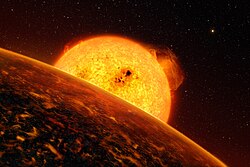Chthonian planet


A chthonian planet (/ˈkθoʊniən/, sometimes 'cthonian') is a hypothetical class of celestial objects resulting from the stripping away of a gas giant's hydrogen and helium atmosphere and outer layers, which is called hydrodynamic escape. Such atmospheric stripping is a likely result of proximity to a star. The remaining rocky or metallic core would resemble a terrestrial planet in many respects.[1]
As there is a lack of gaseous "hot-super-Earths" between 2.2-3.8 Earth-radii exposed to over 650 Earth incident flux, it is assumed that exoplanets below such radii range exposed to such stelar fluxes could have had their envelopes stripped by photoevaporation. [2]
HD 209458 b is an example of a planet that is in the process of having its atmosphere stripped away, though it is not itself a chthonian planet nor is it expected to become one in the near future.[clarification needed] A similar case would be Gliese 436b, as it has already lost 10% of its atmosphere. [3]
COROT-7b may be the first chthonian planet discovered.[4][5]
Chthonia (from Greek: Χθών) means "of the Earth". The term was coined by Hébrard et al., since the term chthonian generally refers to Greek deities from the infernal underground.
See also
- COROT-7b: diameter 1.7 × Earth, mass 4.8 × Earth, orbital period = 20.5 hours[6] (super-Earth candidate)
- Hot Jupiter
- Hypothetical astronomical object
- Kepler-70
Terraforming
The hydrodynamic escape model could be used as a method of terraforming gas giants and other gaseous worlds. The left over core could then be terraformed in the same process as a lava planet.
References
- ^ Hébrard G., Lecavelier Des Étangs A., Vidal-Madjar A., Désert J.-M., Ferlet R. (2003), Evaporation Rate of Hot Jupiters and Formation of chthonian Planets, Extrasolar Planets: Today and Tomorrow, ASP Conference Proceedings, Vol. 321, held 30 June – 4 July 2003, Institut d'astrophysique de Paris, France. Edited by Jean-Philippe Beaulieu, Alain Lecavelier des Étangs and Caroline Terquem.
- ^ Lundkvist et al. (2016), "Hot super-Earths stripped by their host stars", arXiv:1604.05220 [astro-ph.EP]
- ^ "Hubble sees atmosphere being stripped from Neptune-sized exoplanet". Nature. 2015-06-24. Retrieved 2015-11-08.
- ^ "Exoplanets Exposed to the Core". AstroBiology Magazine. 2009-04-25. Retrieved 2009-07-13.
- ^ "Super-Earth 'began as gas giant'". BBC News. 10 January 2010. Retrieved 2010-01-10.
- ^ "Planet : CoRoT-7 b". Retrieved 2009-06-13.

